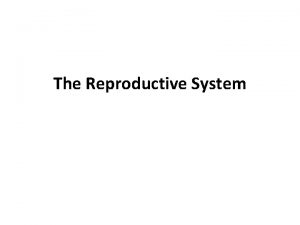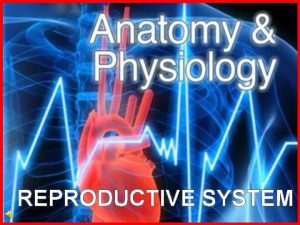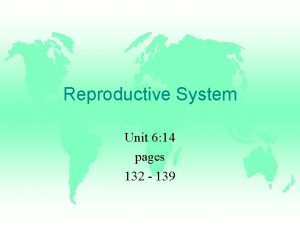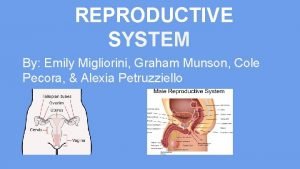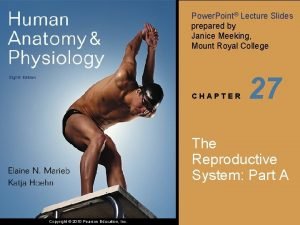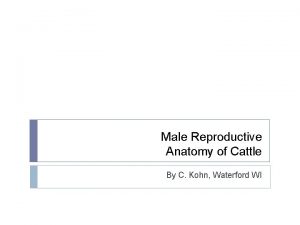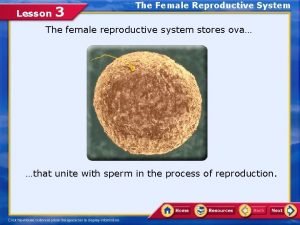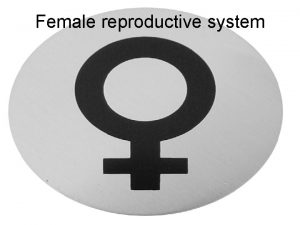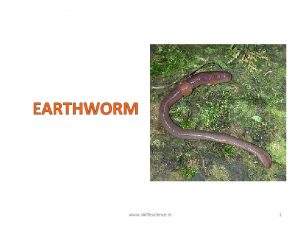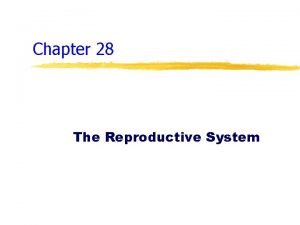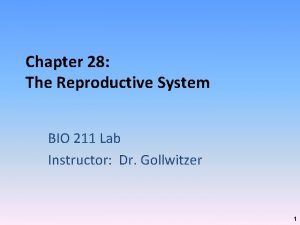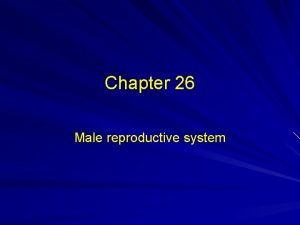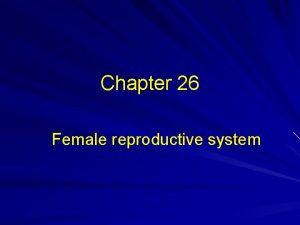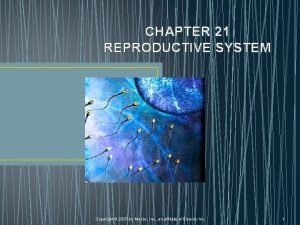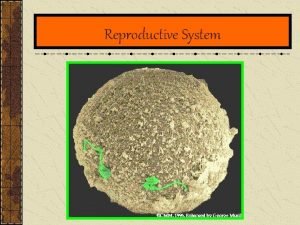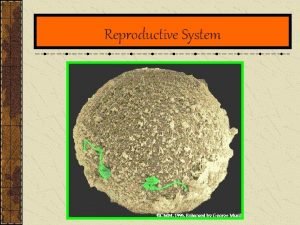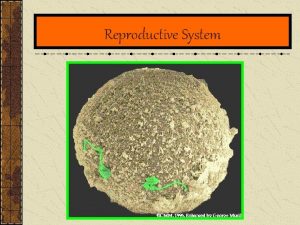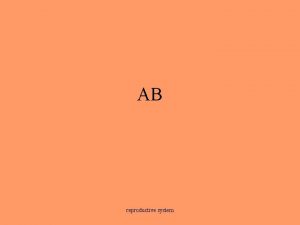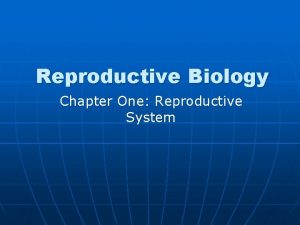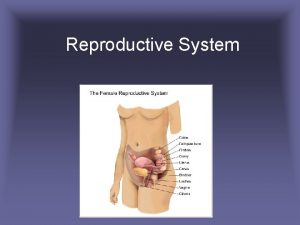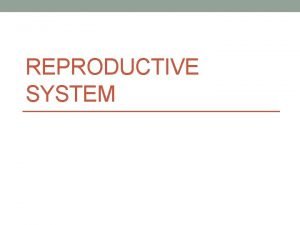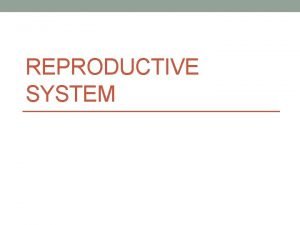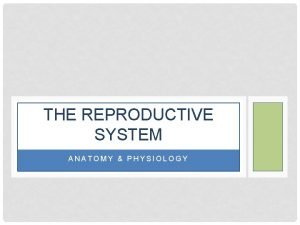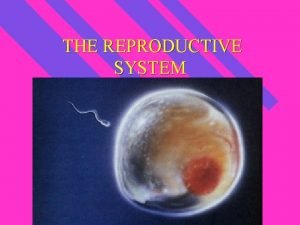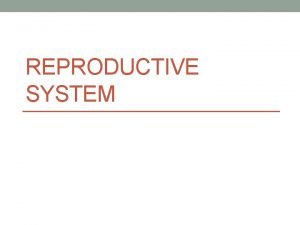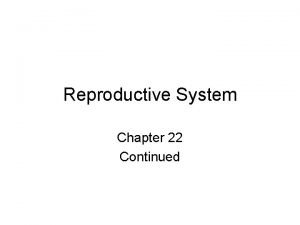Reproductive System AP Reproductive System Functionproduce new life











































- Slides: 43

Reproductive System A&P

Reproductive System Function=produce new life Gonads (sex glands), ducts (tubes), and accessory organs can be found in both males and females

Male Reproductive System Structures: 1) Testes 2) Epididymis 3) Vas deferens 4) Seminal vesicles 5) Ejaculatory ducts

Male Reproductive System Structures: 6) Urethra 7) Prostate gland 8) Cowper’s glands 9) Penis

Male Reproductive System Testes • male gonads (sex glands) • 2 testes • Located in scrotum • Produce male sex cells=sperm or spermatozoa

Male Reproductive System Testes • Sperm are produced in seminiferous tubules located in testes • Scrotum is outside the body to keep the temperature lower for sperm production

Male Reproductive System Testes • Produce male hormones • Main hormone=testosterone • Testosterone=aids in maturation of sperm

Male Reproductive System Testes • Testosterone=responsible for secondary sex characteristics • Secondary sex characteristics=body hair, facial hair, large muscles, deep voice

Male Reproductive System Epididymis • After sperm develop in seminiferous tubules in testes, they enter epididymis • Tightly coiled tube • About 20 feet long • Located in scrotum, above testes

Male Reproductive System Epididymis • Stores sperm while they mature and become motile • Produces fluid that becomes part of semen • Connects with vas deferens

Male Reproductive System Vas (ductus) deferens • Receives sperm and fluid from epididymis • On each testes, it joins with epididymis, extends up into the abd cavity, curves behind the bladder & joins with the seminal vesicle

Male Reproductive System Vas (ductus) deferens • Passageway & temporary storage for sperm • Tubes that are cut during a vasectomy • Vasectomy=sterilization procedure

Male Reproductive System Seminal Vesicles • 2 small pouch-like tubes • Located behind the bladder & near junction of vas deferens & ejaculatory ducts • Have glandular lining

Male Reproductive System Seminal Vesicles • Lining produces thick, yellow fluid that is rich in sugar & provides nourishment for sperm • This fluid composes a large part of the semen

Male Reproductive System Ejaculatory Ducts • 2 short tubes • Formed by the joining of the vas deferens & seminal vesicles • Carry sperm & fluids (which together is called semen) through the prostate & into urethra

Male Reproductive System Prostate Gland • Doughnut-shaped gland • Located below bladder & on either side of urethra • Produces alkaline secretion that increases sperm motility & neutralizes acidity in vagina

Male Reproductive System Prostate Gland • Muscular tissue in prostate contracts during ejaculation (expulsion of semen from body) • This contraction aids in expulsion of semen into urethra

Male Reproductive System Prostate Gland • When prostate contracts, it closes off the urethra, preventing urine passage through the urethra

Male Reproductive System Cowper’s Glands • AKA bulbourethral glands • 2 small glands • Located below prostate & connected by small tubes to urethra • Secrete mucus

Male Reproductive System Cowper’s Glands • This mucus is a lubricant for intercourse • This mucus is alkaline, to decrease the acidity of urine residue in the urethra

Male Reproductive System Urethra • Tube that extends from urinary bladder to outside of body • Carries urine and semen

Male Reproductive System Penis • External male reproductive organ • Also functions in urinary system • Distal end is an enlarged structure=glans penis • Glans penis is covered with a prepuce (foreskin)

Male Reproductive System Penis • Circumcision=surgical procedure to remove the foreskin • Made of spongy erectile tissue • During sexual arousal, spaces in this tissue fill with blood causing the penis to become erect

Female Reproductive System Structures: 1) Ovaries 2) Fallopian tubes 3) Uterus 4) Bartholin’s glands 5) Vulva 6) Breasts

Female Reproductive System Ovaries: • Female gonads • 2 small, almond-shaped glands • Located in abd cavity • Attached to uterus by ligaments

Female Reproductive System Ovaries: • Contain thousands of small sacs=follicles • Each follicle contains an immature ovum (female sex cell)

Female Reproductive System Ovaries: • When ovum matures, follicle enlarges and ruptures to release mature ovum=ovulation • Ovulation usually occurs once every 28 days

Female Reproductive System Ovaries: • Ovaries produce hormones that aid in development of reproductive organs and produce secondary sexual characteristics

Female Reproductive System Fallopian tubes: • • • 2 tubes, attached to either side of the upper part of the uterus 5 inches long Passageway for ovum from ovary to uterus

Female Reproductive System Fallopian tubes: • • • Lateral ends are located above the ovaries, but not directly connected to the ovaries Lateral ends have fingerlike projections=fimbriae Fimbriae help move the ovum into the fallopian tubes

Female Reproductive System Fallopian tubes: • • • Peristalsis moves the ovum through the tubes Cilia line the tubes and help keep ovum moving toward uterus Fertilization=union of ovum and sperm, takes place in tubes

Female Reproductive System Uterus: • • • Hollow, muscular, pear-shaped organ Located behind the urinary bladder and in front of the rectum It allows for the growth & development of the fetus

Female Reproductive System Uterus: Divided into 3 parts: 1) Fundus=top section, where fallopian tubes attach 2) Body (corpus)=middle section 3) Cervix=narrow, bottom section, attaches to vagina •

Female Reproductive System Uterus: • • Contracts to aid in expulsion of fetus Menstruation occurs in uterus Has 3 layers: endometrium, myometrium, perimetrium Endometrium=inner layer, where implantation occurs

Female Reproductive System Uterus: • • • Endometrium=inner, epithelial layer, where implantation occurs If fertilization doesn’t occur, endometrium deteriorates and causes bleeding=menstruation Myometrium=middle, muscle layer

Female Reproductive System Uterus: • • • Myometrium allows for the expansion of the uterus during pregnancy Myometrium contracts to expel fetus during birth Perimetrium=outer, serous membrane layer

Female Reproductive System Vagina: • • Muscular tube Connects cervix of uterus to outside of body Passageway for birth, menstrual flow, & receives sperm Lined with mucous membrane and rugae (to allow for expansion during childbirth and intercourse)

Female Reproductive System Bartholin’s glands: • • AKA vestibular glands 2 small glands Located one on each side of the vaginal opening Secrete mucus for lubrication during intercourse

Female Reproductive System Vuvla: Includes all structures that form the external female genital area 1) Mons pubis=triangular fat pad covered with hair, lies over the pubic area

Female Reproductive System Vuvla: 2) 3) Labia majora=2 large folds of fatty tissue; covered with hair on their outer surfaces; enclose and protect the vagina Labia minora=2 smaller hairless folds of tissue; located within the labia majora

Female Reproductive System Vuvla: 4) Vestibule=area of the vulva located inside the labia minora; contains openings to urethra and vagina 5) Clitoris=erectile tissue; located at junction of labia minora; produces sexual arousal

Female Reproductive System Perineum • Area between vagina and anus • Perineum also describes the entire pelvic floor in males and females

Female Reproductive System Breasts • AKA mammary glands • Function=secrete milk (lactate) after childbirth • Milk ducts exit on the surface at nipples
 Female reproductive ducts
Female reproductive ducts Endocrine system and reproductive system
Endocrine system and reproductive system Function of vagina
Function of vagina Reproductive system function
Reproductive system function Seminal tubules
Seminal tubules Fetus reproductive system
Fetus reproductive system Chapter 16 the reproductive system
Chapter 16 the reproductive system Exercise 42 anatomy of the reproductive system
Exercise 42 anatomy of the reproductive system Female external reproductive system
Female external reproductive system Corpus albicans vs corpus luteum
Corpus albicans vs corpus luteum Epilization
Epilization Unit 6:14 reproductive system
Unit 6:14 reproductive system Figure 28-1 the male reproductive system
Figure 28-1 the male reproductive system Reproductive system jeopardy
Reproductive system jeopardy Male fallopian tube
Male fallopian tube Figure 16-1 is a sagittal view of the male reproductive
Figure 16-1 is a sagittal view of the male reproductive Graham munson
Graham munson Reproductive physiology
Reproductive physiology Poultry reproductive system
Poultry reproductive system Plants reproductive system
Plants reproductive system Art-labeling activity: the male reproductive system, part 1
Art-labeling activity: the male reproductive system, part 1 Objectives of poultry production
Objectives of poultry production Male reproductive system information
Male reproductive system information Where is the sperm stored
Where is the sperm stored Male cow reproductive system diagram
Male cow reproductive system diagram Male anatomy front view
Male anatomy front view Lesson 3 the female reproductive system
Lesson 3 the female reproductive system Examples of asexual reproduction
Examples of asexual reproduction Function of male reproductive system
Function of male reproductive system Fish reproductive system
Fish reproductive system Ligaments of female reproductive system
Ligaments of female reproductive system Main function of female reproductive system
Main function of female reproductive system In pila fertilization
In pila fertilization Juxtaposing in earthworm
Juxtaposing in earthworm Fetal pig female reproductive system
Fetal pig female reproductive system Marine fishes
Marine fishes Female part of a flower
Female part of a flower How to care reproductive system
How to care reproductive system Uterus perimetrium
Uterus perimetrium Figure 28-1 the male reproductive system
Figure 28-1 the male reproductive system Primary sex organ of the male reproductive system? *
Primary sex organ of the male reproductive system? * Female reproductive organs sagittal section
Female reproductive organs sagittal section Chapter 21 reproductive system review questions
Chapter 21 reproductive system review questions Lesson 20.2 the male reproductive system
Lesson 20.2 the male reproductive system





